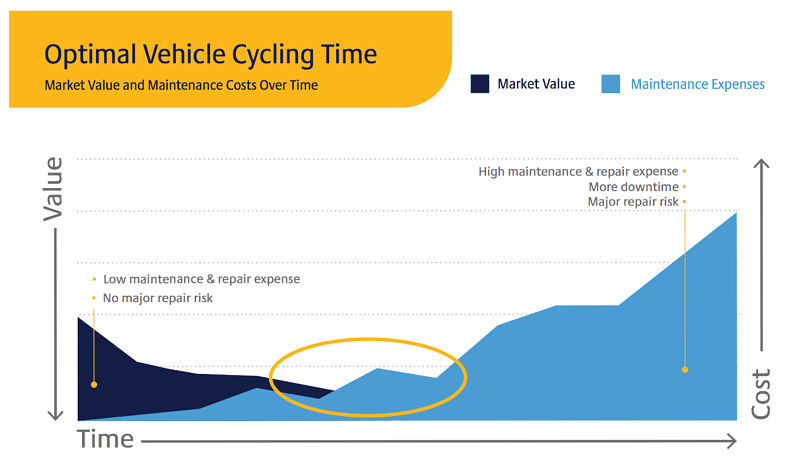How Fleet Lifecycle Management Lowers Total Cost of Ownership

While some businesses may be unfamiliar with fleet lifecycle management, the practice is essential to lowering your total cost of ownership. Not only that, it ensures your vehicles continue to operate well and generate revenue for the business. A data-driven life cycle management strategy results in decreased downtime, fewer repairs, and lower fuel costs while maximizing vehicle resale value.
In this blog, you’ll learn the cost-saving benefits of a managed fleet life cycle strategy for businesses of all sizes.
What is Fleet Life Cycle Management?
Fleet vehicle life cycle management refers to strategically acquiring and disposing of vehicles to lower the total cost of ownership.
The three key areas involved in vehicle life cycle management are:
- Vehicle Market Value: The estimated value of a vehicle based on its make, model, age, mileage, condition, and other factors determine its worth in the market.
- Maintenance Costs: The costs associated with keeping a vehicle in good working condition, including regular preventative services, repairs, and replacement of parts.
- Fuel Costs: The costs of fueling a vehicle, including the cost of gasoline, diesel, or other fuels used to power the vehicle.
Why Is Fleet Life Cycle Management Important?
Fleet life cycle management is the first step to minimizing your total cost of ownership. As a vehicle ages, its market value decreases, while its operating costs rise. The key is to replace vehicles when their net expenditure is at the lowest point.
Proper fleet life cycle management allows you to operate a newer fleet for less money. In addition to lower fuel and maintenance costs, newer vehicles typically have more safety features like collision warnings and automatic braking that help keep drivers safe and reduce accidents.
Many companies choose to purchase fleet vehicles rather than lease. Once the vehicle is paid for, they frequently drive it until a major mechanical repair arises. The cost is frequently more than the value of the vehicle. But as a vehicle’s mileage increases, its fuel and maintenance costs rapidly increase and it is forced into more downtime for repairs, interrupting business operations and decreasing productivity.
If you don’t have reporting in place, these rising expenses and downtime can go unnoticed. You may end up overpaying on operation costs and miss out on good returns when selling your vehicles.

How to Reduce Your Total Cost of Ownership
Fleet Fuel Costs
A fleet fuel card can help your business manage fuel costs. Most are accepted at over 98% of fuel stations across the United States and allow employees to access all fuel vendors to take advantage of the lowest prices. They assist in preventing unauthorized fuel purchases and reduce the administrative load as all purchases are on one invoice.
Good driver habits like reduced idling, maintaining the speed limit, and proper route plan also contribute to fuel cost savings. Amending your fleet policy or investing in driver training can help discourage bad driver habits and increase your vehicles’ miles per gallon.
Fleet Maintenance Costs
A managed fleet maintenance program will help ensure your vehicles are getting the service and repairs they need. Preventive maintenance extends vehicle lifespan, increases resale value, and reduces the occurrence of major breakdowns and costly repairs. Downed vehicles result in missed billable hours or added costs of sourcing an interim replacement vehicle.
Fleet Lifecycle Management
Fleet lifecycle management is the strategic acquisition and disposal of vehicles to get the most value out of them and minimize the total cost of ownership. It compiles all of the data surrounding vehicle expenses and pinpoints the optimal time to cycle a vehicle out of your fleet. The optimal disposal point occurs while the vehicle still holds resale value and before fuel and maintenance costs have skyrocketed.
As vehicles age, maintenance and fuel costs rise while the resale price falls. Monitoring these costs is crucial to pinpointing the best time for disposal. Learn more about fleet vehicle replacement and lifecycle management, and how it can minimize your TCO.
Benefits of Fleet Lifecycle Management
- Reduces fuel costs: Although fuel costs appear unavoidable, you can find cost-saving opportunities by tracking your fuel expenditures. Having a complete understanding of your fleet’s fuel spending provides insight into underperforming assets and helps detect potential cases of fuel theft.
- Reduces maintenance costs: Know when to cut your losses. According to a study by Automotive Fleet in 2021, repair costs average $14.80 per vehicle when in service for one year and increase to $68.62 per vehicle after being in service for over three years.
- Maximizes resale value: Companies often calculate depreciation under the assumption it will be valued $0 at the end of its predicted useful life. However, assets can be valued at 20% or more of their purchase price after 5 to 6 years of useful life and 10% of their purchase price after 10 years.
- Minimizes downtime: Know exactly where you stand and pinpoint any outliers in your fleet.
- Keeps drivers safe: Keep your employees safe and avoid costly damage to your fleet.
By properly tracking data on these expenses, you’ll be able to determine how much you’re spending on each vehicle per month, and when is the optimal time to cycle a vehicle out of your fleet.

How We Can Help
Over the years at Ewald, we’ve gathered robust data on the life cycle strategies that work best for different industries. We provide different recommendations for different types of vehicles and then adjust a company’s lifecycle strategy based on both industry data and our experiences with other clients that are within the same industry.
We look at the specific make and model of a vehicle and what it is being used for. If a particular vehicle is being driven more often or has more demanding usage, we will cycle it out sooner than a vehicle that isn’t being used as hard. Different makes and models age differently, and our programs can include preventative maintenance to keep all vehicles operating strong.
We also monitor market trends to determine depreciation milestones. For example, certain pickup trucks should be sold before 100,000 miles, while others can surpass that and still hold their value.
Our focus is on finding the replacement point where a vehicle’s market value, maintenance costs, and fuel costs intersect each other, before market value decreases and operating costs rise.
Final Thoughts
Life cycle management is a hallmark of fleet optimization. It will help you save on fuel and maintenance costs, maximize resale value, and minimize downtime. Understanding the point where your fleet’s fuel, maintenance, and depreciation costs are still low will allow you to strategically cycle vehicles out of your fleet and maintain a healthier bottom line for your business.

